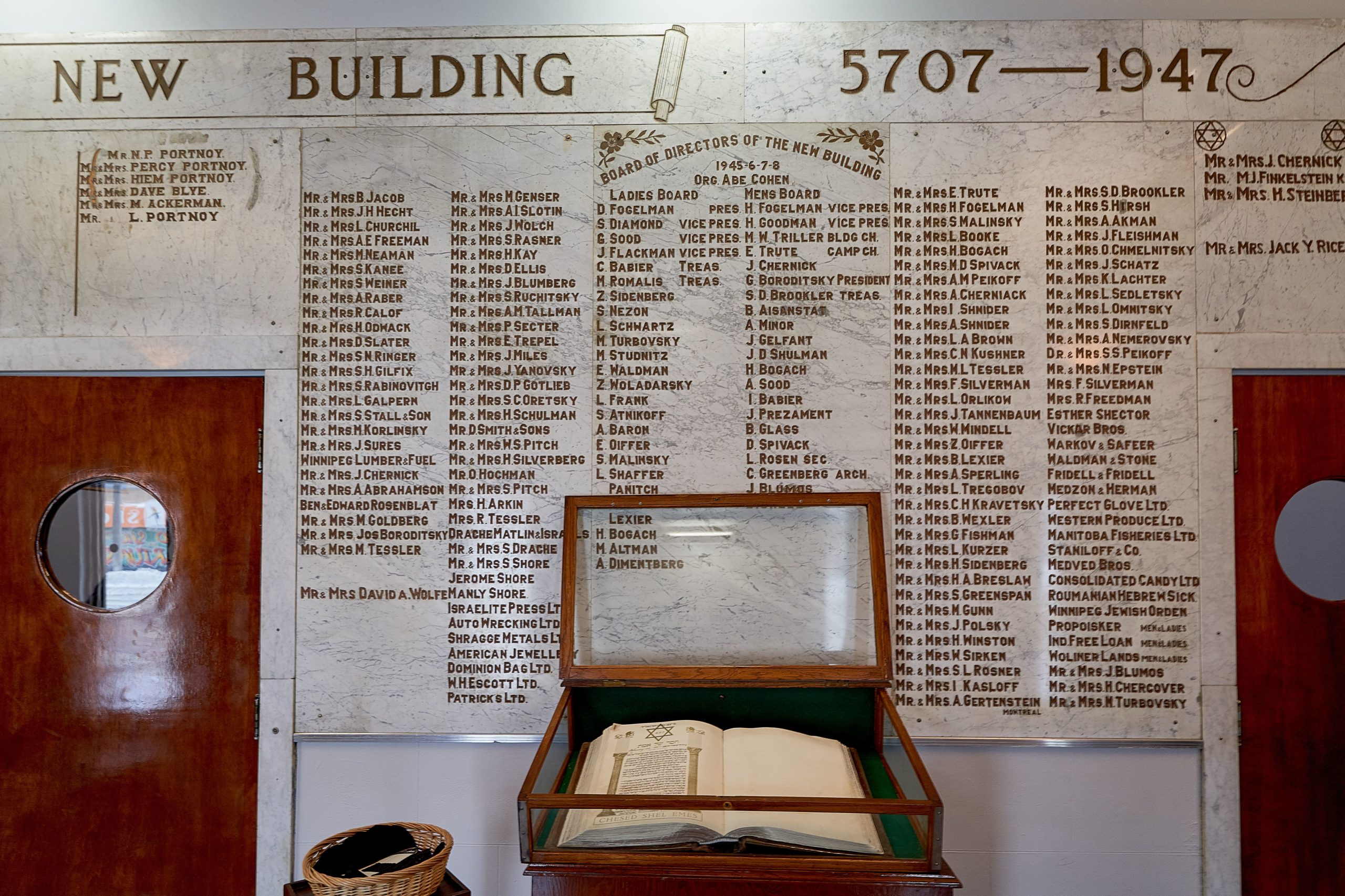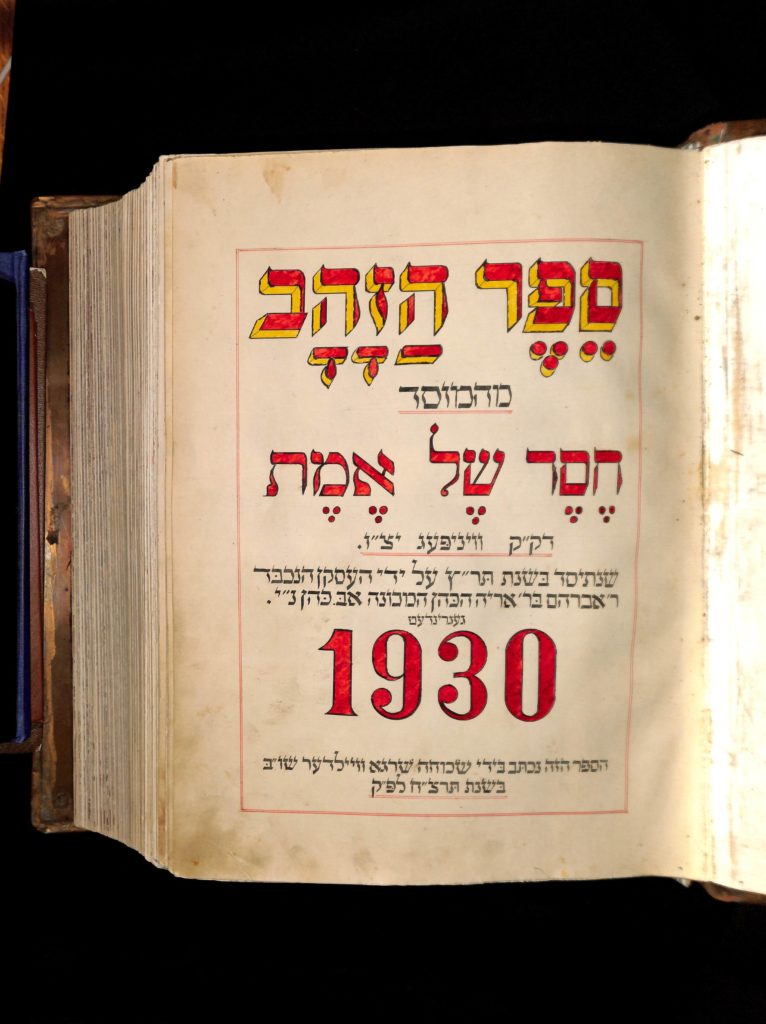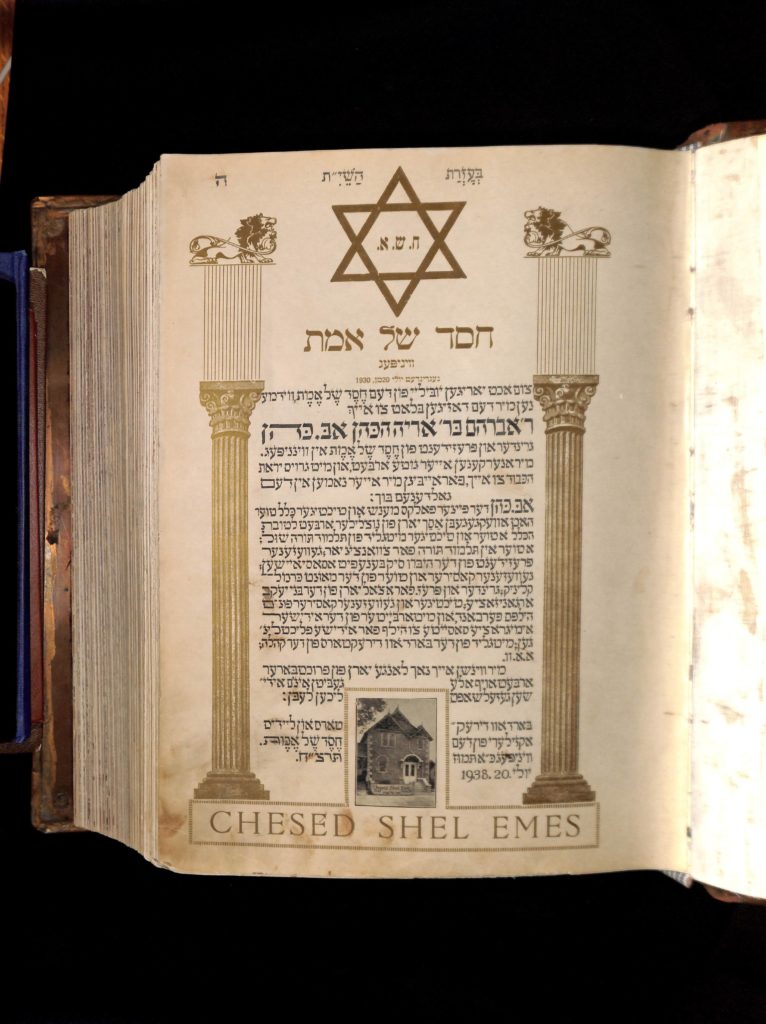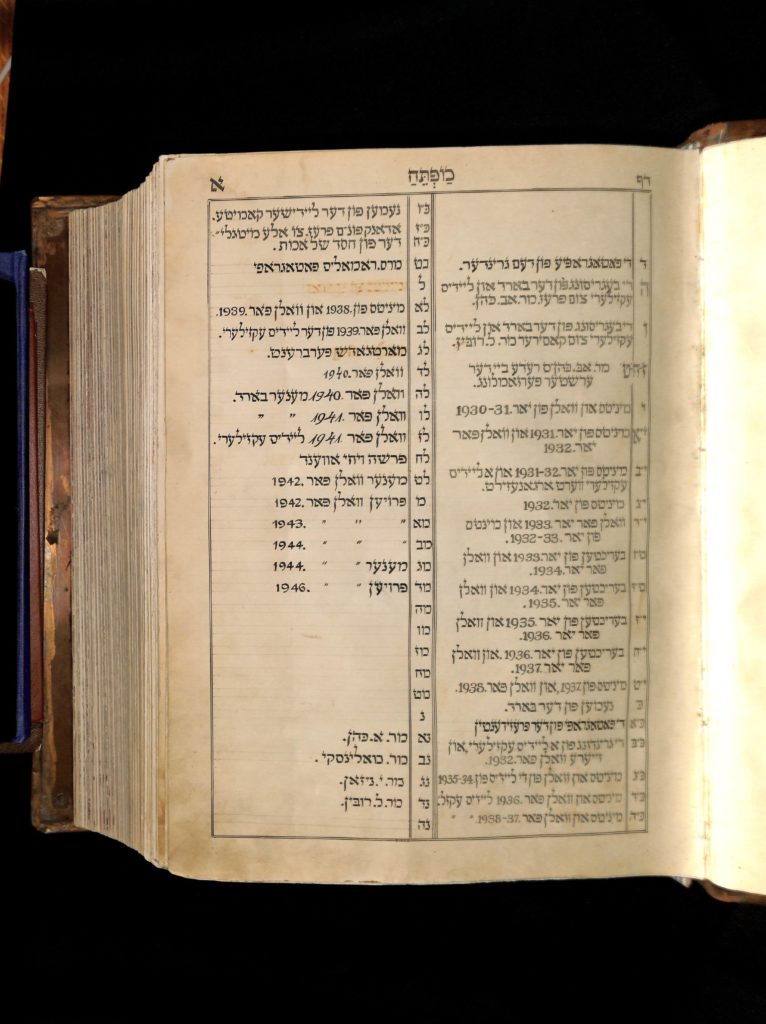Chevra Kadisha as we know it dates back hundreds of years, but our Chesed Shel Emes was established in 1930.
Past President, Ike Permut z'l often described events pre-1930, when deceased were kept at home until the funeral, and members of the Chevra Kadisha attended at the house to prepare the body. In the 1920's, a group of community minded volunteers recognized the need for the Jewish community to have a permanent home for the Chevra Kadisha, to ensure the dignity of the deceased, and to establish our sacred work as an essential cornerstone of the community.
A 25 year old house was purchased at 1023 Main Street and served as the Jewish mortuary and funeral home. The adjacent chapel, built in the 1940's, is a testament to the hundreds of hours devoted by the Ladies Auxiliary to teas, concerts and fundraising efforts. The Chapel was opened in November 1947 for funeral services, synagogue services, community concerts, dinners, teas and dances. A truly unique space, the chapel was lovingly restored in 2012.
We carry on their legacy with pride and gratitude.
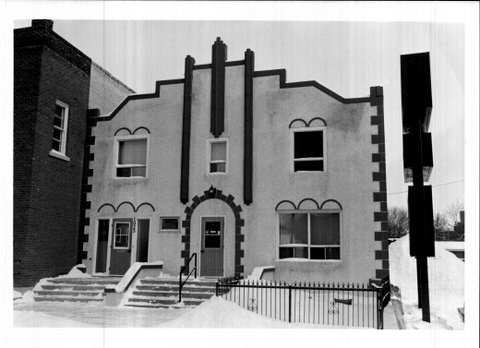
The following was written by Dr. Jack Cohen z’l in the late 1990’s, as a tribute to the memory of his father ( and our founder) Abe Cohen. Dr. Cohen served as our treasured senior member of the Board and attended meetings well into his 90’s. Dr. Cohen was named as an Honorary Life Member of Chesed Shel Emes in November 2005.
Translated from the Hebrew, Chesed Shel Emes means “Charity of Truth”or “Charity of True Loving Kindness”. One community newspaper referred to the Society and its holy work as “a monument to Jewish community dedication”
These are all accurate descriptions of Winnipeg’s Chesed Shel Emes Society, whose Chapel and mortuary stand austerely at 1023 Main Street in Winnipeg’s North End. The Establishment of the Chesed Shel Emes in 1930 relieved families of the burden of housing and preparing their deceased for burial. The organization assumed the responsibility of preparing the deceased in the Orthodox tradition and assisted families in making burial arrangements.
The Chesed Shel Emes is a publicly operated, nonprofit Jewish funeral chapel and mortuary, one of a few remaining in North America. We are an autonomous body, independent of any other community organization, and operate within traditional Halachic parameters.
The deceased are prepared for burial at the Chesed Shel Emes mortuary according to Orthodox Halacha. The Society cares for the deceased on its premises from the time of death until it is removed for the funeral service and burial, or is shipped to Israel or another destination for interment.
Funeral services may be conducted in the Chesed Shel Emes chapel.
The practice of negotiating fees for service was discontinued in the 1950s and a standard, non-profit fee was established by arrangement with Winnipeg’s four Jewish cemeteries, with fees going in part towards the upkeep of the Chesed Shel Emes.
When the Chesed Shel Emes is notified of a Jewish death the Director arranges the transfer of the deceased to the funeral chapel. According to Halacha, out of respect, the departed should never be unattended and a Shomer should be present until the funeral. While it is a mitzvah for the family to provide the Shomrim, the Chesed Shel Emes can make one available at the family’s request.
Prior to the funeral service, members of the Chevra Kadisha (Holy Society) perform their primary function of preparing the deceased for burial. Separate Chevra Kadisha committees care for women and for men. They bathe and ritually purify the body, which is then dressed in a white natural fiber shroud. The deceased is placed in the simplest of coffins. For men, the Tallis worn during life is placed around the shoulders over the shroud. Membership in the Chevra Kadisha is considered to be a great honor and one of the highest Mitzvahs.
The role of the Chesed Shel Emes is to ensure adherence to Orthodox Jewish guidelines for death and burial. Jewish laws and customs concerning death and mourning show respect for the dead and provide support for the mourners.
In earlier days, when a person died, it was customary to place the body on the floor of his or her home. A candle would burn at the head, and the feet were pointed towards the door while a Shomer stayed with the deceased throughout the night.
This practice caused many an upset. William Pitch, who chaired the Chesed Shel Emes board from 1961 to 1976, noted in a 1973 column in The Jewish Post, “It’s hard to conceive that, prior to 1930, a deceased person had to be kept at his home, in the summer, at temperatures of over 75 degrees (25 Celsius) until family arrived, often from distant places. Many times it took two to three days, and often there were small children the house”
The first of many efforts to create a “Jewish House of Ritual Purification of the Dead” was made in 1921. However, it was not until 1929 that efforts were renewed under the leadership of Abe Cohen, a successful businessman. Cohen was a very active member of the community as a founding member of both the Hebrew Sick Benefit Association and the Volyner Landsmanshaft and as treasurer of the Mount Carmel Clinic.
Winnipeg’s Chesed Shel Emes came into being in the summer of 1930. Abe Cohen was elected founding president, and he retained the chair until his death in 1944. The first executive included Vice Presidents Messrs B. Cohen and Zelbovitch, Treasurer L. Rubin, and Honorary Secretary S. Tcherashny. The executive committee consisted of Messrs. A.B. Levine, R. Cohen, J. Kaufman, H.Cohen, A. Boroditsky, Koretsky, Halpern, Rookler, Winestock, Kirshner, Ragolin, Tcherashny and Knelman.
After a Jewish victim of a traffic accident was taken to a non-Jewish undertaker early in 1931, there was a renewed call for the Chesed Shel Emes to build a Jewish funeral home. Although it was near the height of the Depression, there was general agreement that the Jewish community should be prepared to build a funeral home as soon as possible. To sharpen the community’s awareness and raise membership for the Chesed Shel Emes Society, a concert was held at the Palace Theater on Selkirk Avenue. Memberships were solicited at one dollar per year.
That September, Abe Cohen was re-elected president by acclamation. Membership had reached 400 and the Society had looked after five needy cases among its case load. A building fund was established and all synagogue presidents in the city were asked to put out a bowl for donations on Erev Yom Kippur.
By March 1932, the Society had bought a house at the corner of Burrows and Main and intended to commence renovations after Pesach. An appeal went out to the Jewish communities of Winnipeg and Western Canada for their support. The project ran into a temporary roadblock with opposition from neighbors who feared that the funeral home would lower property values. The Society established itself as a religious congregation, and received support from Jewish elected officials including Aldermen Moishe Gray and John Blumberg, and MLAs Marcus Hyman and Colonel William Tobias.
The Chesed Shel Emes Society was finally able to consecrate its chapel on October 6, 1933.
The event was described in detail in the (Yiddish language) Israelite Press.
About 2000 attended as Abe Cohen reviewed the three year-old Chesed Shel Emes Society’s achievements. He was followed on the dias by Rabbi I. I. Kahanovitch, Rabbi I. Horowitz, Rabbi A. Silverstein and Rabbi Herson as well as community representatives.
Five hundred dollars were collected, including $150.00 presented by Mrs. Slutsky on behalf of the Ladies’ Auxiliary. The contributors’ names were carved into a marble panel which is still displayed on the west lobby wall of the Chesed Shel Emes. The Winnipeg Jewish Orphanage Choir, directed by S. Ostrow performed, and a buffet prepared by the Ladies’ Auxiliary was served.
In the 1930s and 1940s the Ladies’ Auxiliary was a major source of funding. Money was raised through teas, door-to-door canvassing and collections at the cemeteries. From June to September of 1935 alone, the Auxiliary raised over $300.00 – a significant sum at a time when the upkeep of the chapel was about $60.00 a month. Funds were also raised through concerts, Erev Yom Kippur contributions, donations and memberships sold at a dollar per year.
The Chesed Shel Emes served a wide area including Kenora, Beausejour, Portage la Prairie, Yorkton and Ituna, Saskatchewan. By mid-1935, the chapel had handled 47 burials, of which 27 were free of charge for homeless, indigent or immigrant families.
Indigent burials are still handled by the Chesed Shel Emes and rotated among the Jewish cemeteries with a financial contribution by the City or Province.
The chapel was remodeled and decorated in 1937. That year, 50 cases, including 13 from rural areas, were handled by the mortuary. About 35 per cent of the cases were handled without charge. By the end of 1937, the Chesed Shel Ernes was left with a mortgage of just $1000.00 which the board hoped to pay off within a year.
In 1938, the Society launched a new fund-raising venture, The Golden Book, which was to record the history of all the Jewish organizations and societies in Winnipeg. There was also a Book of Life established for donations honoring parents.
Among special synagogue services celebrated in the chapel were regular Yom Tov services and monthly Rosh Chodesh services. Every December, Chesed Shel Emes hosted a celebration honoring the reading of the Torah portion “Vayechi”, which describes the last hours of Jacob’s life and his burial. A traditional observance marked by Jewish communities worldwide, it was observed in Winnipeg with a well-attended dinner and dance.
In March of 1939, the community had another reason to celebrate. The Chesed Shel Emes paid for and burned its mortgage, a momentous occasion marked by a banquet at the Talmud Torah hall. That year, a cooling room, wired with a temperature security system, was added to the chapel mortuary.
By the early 1940s, the Chesed Shel Emes was handling so many cases that space was becoming a problem in its Main Street chapel. As Isaac Trute, the building committee chairman at the time, noted: “Imagine when two funerals take place at the same time and there is another deceased in the cold room awaiting his or her turn. Friends and loved ones come to pay their last respects and can’t get in because the chapel is packed. If this happens in winter and they have to wait outside, they must certainly feel the need for a larger building?’
In 1945, adjoining land was purchased for a new chapel. A campaign to raise $30,000.00 toward the new structure was chaired by Mr. and Mrs. Isaac Trute. M.W. Triller, Building and house chairman, and Mr. and Mrs. H. Fogelman, vice-presidents, mustered community support.
Mrs. Fogelman was the president and major force of the Ladies’ Auxiliary for almost its entire existence.
Under her leadership, the auxiliary raised $10,000.00 toward construction of the new chapel. The cornerstone was laid on November 29, 1946 and the new building opened almost a year later, on November 23, 1947. The total cost was $60,000.00.
Mr. Trute described the new chapel as “the pride, not only of Winnipeg, but of all Canada and America. Once again, the older generation has added a new reality to the history of the future, a real and meaningful asset and a lesson for the younger generation that, if you want to, you can build and create”.
Another important step was taken in 1947 when the board altered the membership by-laws to include all subscribers, and proposed enlarging the board to broaden community representation.
Following Abe Cohen’s death, the presidency was filled for short periods by Messrs. A. Molinsky, Goodman and H. Fogelman. The first president after the new building was erected was J.Boroditsky who served until 1951. He was succeeded by Sam Pitch (1951 – 1961).
Sam Pitch was succeeded in 1961 by his son William (Bill) Pitch, who chaired the board until 1976. Ike Permut was elected chairman in April of 1978 and was the longest serving board chairman, serving until 1996.
As Permut observed, the institution faced some difficult times in the 1960s and 1970s during wide societal changes. Old institutional traditions were losing their relevance for the Baby Boom generation. Although people continued to use the Chesed Shel Emes, they began to take their institutions for granted.
Membership, which had been declining, was eliminated. Every synagogue was invited to appoint representatives as board members. The board of directors was expanded to 30 including 12 to 15 people from the general Jewish community. These moves began to generate renewed interest.
The constitution was revised and the organization divided in the early 1980’s. The mortuary provides a service to the public as defined in The Government Services Act, and the Chesed Shel Emes Synagogue is a venue for religious services. This division of services defined the organization as a charitable institution.
A $100.00 surcharge was added to the Chesed Shel Emes service charges in June 1986, to establish a reserve fund for building improvements and maintenance.
Volunteers welcomed
Volunteers are welcomed as Shomrim or members of the Chevra Kadisha, or to participate in Minyanim. “We must remove the mystique surrounding the Chesed Shel Emes and familiarize young people with the institution’s functions,” said Permut. Joseph Wolinsky Collegiate senior students tour the building annually. Anyone interested in volunteering is invited to call the office.
“We have tried to maintain the Chesed Shel Emes,” said Permut, “so that members of the community have available to them proper preparation for burial in the Orthodox manner. We follow tradition. We feel that, with the continued support and participation of the community, we can keep going forward to maintain this vital service as a publicly operated, nonprofit Jewish funeral service in North America.”
To commemorate memorials or other occasions bequests and donations are gratefully welcomed. Please contact our executive Director at 582-5088 for further information
This booklet is an original program from the Opening of the Chapel in 1947, and provides a fascinating look into the community at that time. The booklet is in Yiddish and English ( actually starts on the Yiddish side) .
View or download the Opening the Chapel booklet

The Golden Book sits in our Chapel Foyer, a collection of the stories of our founders. Written in Yiddish, this ornate book is a treasure trove of information.
The stories of the individuals reflect the stories of the foundations of our Jewish community.
